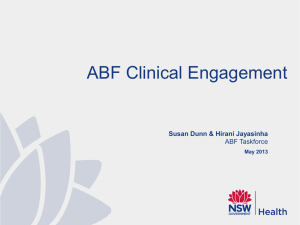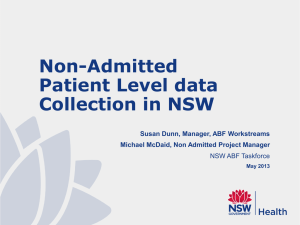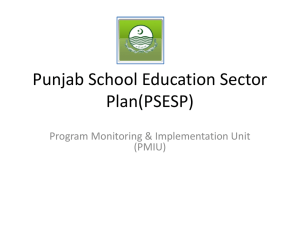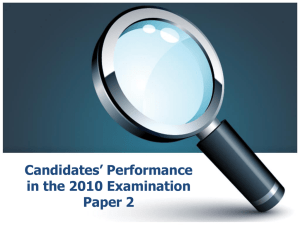Sandra Thompson and Julia McGinty, NSW ABF
advertisement
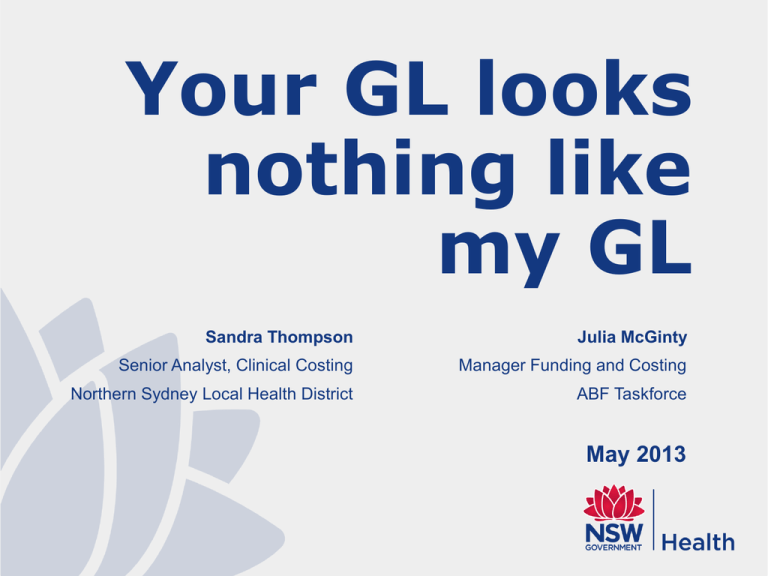
Your GL looks nothing like my GL Sandra Thompson Julia McGinty Senior Analyst, Clinical Costing Manager Funding and Costing Northern Sydney Local Health District ABF Taskforce May 2013 Introduction Transformers – Battle between noble Autobots (led by the wise Optimus Prime) and the devious Decepticons (commanded by the dreaded Megatron) – Vehicles turn into robots – Allspark, a mystical talisman that would grant unlimited power to whoever possesses it General Ledger (GL) – Patient costing is the ‘Allspark’ mystical talisman as it can be very powerful information Key GL Challenges Fundamental requirement of costing is aligning expense with activity The General Ledger structure needs to reflect audit, budget and financial accounting guidelines The GL should be simple and clean with a Management Reporting System sitting on top of it We try to make it a Management Reporting System to satisfy our operational requirements Trying to get the GL to be all things for many requirements often results in a complicated and messy dataset Key GL Challenges NSW has Local Health Districts – the largest being Hunter New England, which has 41 hospitals Clinical Networks, such as mental health or renal services operate across facilities within an LHD Outreach services may operate out of one hospital to many hospitals, especially in the rural LHDs Historical emphasis on Net Cost of Service performance What do we need from the GL? Cost Centre – Structure and accuracy Account Code – Structure and accuracy Adherence to Business Rules Cost Centre – Structure and Accuracy 50,000 General Fund cost centres in NSW – ranging from a couple of 100 in one LHD to over 7,000 in another LHD Direct and Indirect Cost Centres – 6 or 7 character code (6 numeric +/- 1 alpha) – One LHD – last 3 characters constant – CXXX100 is for ED – C819100 Excellent Hospital ED, C829100 Fantastic Hospital ED – One LHD – no structure Indirect Cost Centres – Expenses that need to be distributed by different overhead allocation statistics – utilities and workers compensation premium Cost Centre – Structure and Accuracy Unallocated Cost Centres = Dumping Grounds – A number of LHDs have an ‘Unallocated Cost Centre’ for every hospital and LHD wide service/department – July to December 2012 – nearly $36m in expense in unallocated cost centres - 9.28% of total expense in one of these LHDs – Mixture of direct and indirect expense – pathology charge, depreciation, domestic supplies, fuel light and power charges, agency salaries and wages Correct Cost Centre – Prosthesis rebate in wrong hospital – NCOS result was great, patient level costing prosthesis cost bucket was wrong – Medical Imaging cross charge in CE Cost Centre – Invoices posted to one cost centre, accruals posted in another Account Codes – Structure and Accuracy NSW has 1,600 expense account codes – Specificity is variable – A170570 – Herbs & Spices A100210 – S&W Base Nursing NSW has 59 costing expense account codes Standard Mapping Table has been developed Account Codes – Structure and Accuracy Correct Account Codes – S&W Other – nearly 2% of total S&W – more than $100m across NSW – Business Unit cross charging – one account code which maps to Admin Expenses Costing Account Code, for services relating to domestic, catering and maintenance – each of which need to separately reported for costing - $12m in one LHD – Use an ‘unused’ account code, if there is no appropriate account code – A180025 Coal for $56m of purchased clinical services Business Rules Adherence to the Business rules for the Standard Chart of Accounts – Especially for recoups (credit expense) and recoveries (revenue) Why does it matter? A LOT of time is spent transforming the GL for patient costing processes More regular and timely costing is made that bit more difficult MORE IMPORTANTLY all the changes made to cost centres and account codes results in the costing GL looking very different to the FMIS GL Cost Centre Managers, Business Managers, Finance staff do not recongnise the numbers Time is spent explaining why the changes were required and what was done rather than reviewing the results Engagement Incorporation of costing account code and cost centre mapping tables in Statewide Management Reporting Tool facilitates monthly ABF Performance reporting. Refer issues directly back to Finance Departments – credit expenses The District and Network Return requires Chief Executive sign off Internal Audit Program developed Six monthly costing – identify GL issues sooner rather than later Building Partnerships and Advocacy ABF Taskforce attends the CFO meeting with all the LHD/SHN Directors of Finance Quarterly state meetings with Finance and Costing Teams Accountants in the ABF Taskforce who can talk the talk with the LHD/SHN accountants when required Refer issues to appropriate Directors of Finance as required on behalf of costing officers High level support really makes a difference – One LHD CE sat in on every meeting the costing team had with the cost centre managers! Education All presentations that reference data quality include references to GL data quality The 3 C’s – Counting, Coding and Costing Coding is not just ICD-10-AM The greatest impediment to regular costing is not uncoded records, but the General Ledger Encompass all levels of the organisation – so many staff input data into the GL – probably more than PAS, if you consider all the ordering and journaling The patient journey is not just clinical, but also financial COST CENTRE CREATION / MAINTENANCE FORM New Cost Centre Y/N Name of Cost Centre: Y SMRT PROJECT CODE e.g. 10000 FACILITY MATRIX If this cost centre covers MORE THAN ONE FACILITY, on what BASIS should the costs be distributed to facilities. Facility Description Manly Hospital Mona Vale Hospital Royal North Shore Hospital B212 B214 B218 PROVIDE EITHER A OR B A. OVERHEAD COST CENTRE DETAILS (How and where to allocate.) Cost Centre type What w ould be a reasonable overhead allocation statistic to allocate these costs w ithin facilities? Should these costs be allocated to all cost centres w ithin the facility? If not how should they be constrained? E.g. Surgery cost centres only or exclude Mental Health Link to activity OR B. FINAL PRODUCT COST CENTRE - PROGRAM DETAILS Inpatient Services % Provide details of activity area Ambulatory Services % NAPOOS Clinic Name Other Services % TOTAL Provide Details 0.00 Publishing Results There is nothing quite like a published result which looks a bit funny to assist with engagement 2011/12 Average Cost for Selected Hospitals G46C - Complex Gastroscopy, Sameday $3,000 $2,500 $2,000 NSW Ave $1,500 $1,000 $500 $A B C D E F G H I J K L M N O The funny results may be related to patient data, but may also be related to GL data, or both How do we know it is changing? Costing officers are being called and asked their opinion about the treatment of a cost centre or an account code by Finance teams Budgets are being recast Staff are being paid from multiple cost centres to reflect Outreach services More engagement and openness Further opportunities Patient level costing reconciliation with project acquittal reporting GL data KPIs – we have them for admitted patient data collections – why not the financial data collection – Business Unit eliminations – Clinical expenses (MSS, drug, prosthesis) in non clinical cost centres – % of expense in ‘Other’ type account codes – Other S&W – % of expense in account codes across all cost centres Why does it REALLY matter? This is not about transforming the GL just to improve the rigour of patient level costing – although that is important We can’t embed Activity Based Funding as a management tool if we can’t accurately unpack the cost to start addressing unwarranted clinical variation


